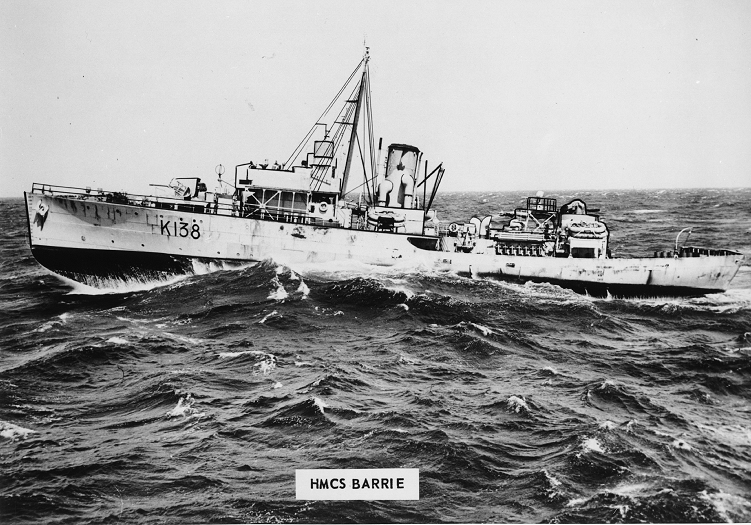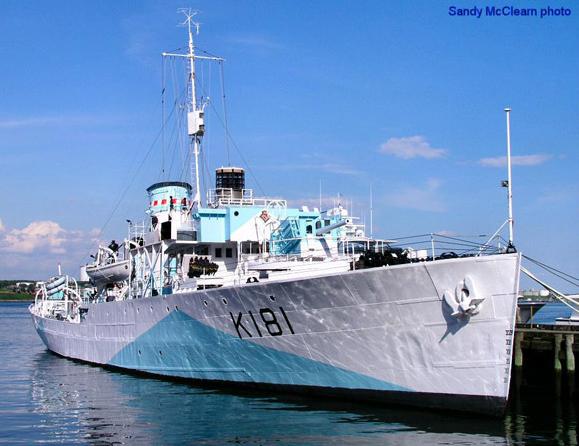I was reminded today of her via Claude's retweet about the HMCS SACKVILLE
Even if you've read this FbF in the past - give it another read.HMCS Sackville...preserving Canadian history! To learn more about the ship and Canada's Naval Memorial please visit: https://t.co/Cszk4QKkCi pic.twitter.com/fjxlzxvkaw— BattleAtlanticPlace (@BOA_Place) January 5, 2017

What happens when a Navy finds itself short and has to play catch-up until the yards can design and build a more capable fleet? Sink all its funds into a few big ships and then hold its breath? Perhaps build good enough until you get yourself straightened out? Go smart?
They were a stop-gap measure to take the strain of convoy protection until large numbers of larger vessels — destroyers and frigates — could be produced. Their simple design using parts common to merchant shipping meant they could be constructed in small commercial shipyards all over the United Kingdom and eastern Canada where larger ships like destroyers could not be built. Additionally, the use of commercial machinery meant that the largely reserve and volunteer crews that manned them were familiar with their operation.Yep, you knew they were going to make it to FbF - The Flower Class Corvette from one of the books on Phibian's professional reading list (hey, there is an idea I never get around to), The Cruel Sea
* 1 x 4 in (102 mm) BL Mk IX gun,Range 3,500 nautical miles at 12 knots, and oh boy did they made a lot of them; 267. Duty is as duty does - the Battle of the Atlantic would have been lost without them.
* One QF 2 pounder naval gun (40 mm) "pom-pom"
* Six x 20 mm Oerlikon anti-aircraft guns
* One Hedgehog A/S Mortar
* Depth charge projectors
Service on corvettes was cold, wet, monotonous and uncomfortable. The ships were nicknamed "the pekingese of the ocean". They had a reputation of being very bad at rolling in heavy seas, with 80-degree rolls (that is, 40 degrees each side of the normal upright position) (check out the pics here) being fairly common - according to Nicholas Monsarrat they "would roll on wet grass" - however, they were very seaworthy ships, and no seaman was ever lost overboard from a Flower during WW2.How is this for you Snipes out there.Flower corvettes provided the main escort duties during the critical Battle of the Atlantic, and so were in the thick of the fight. Their primary aim was to ensure that merchantmen survived the crossing rather than sink U-boats, and so if a convoy encountered a U-boat a typical action would involve the corvette forcing the submarine to dive (thus limiting its speed and manoeverability) and keeping it underwater (and pre-occupied with avoiding depth charge attack) long enough for the convey to pass unmolested. This tactic was stretched to the limits when the U-boats made a 'wolf-pack' attack, intended to swamp the convoy's defences, and the Flower's low top speed made effective pursuit of a surfaced U-boat impossible.
Radar, Huff-Duff radio direction finding, depth-charge projectors and ASDIC meant that the Flower was well equipped to detect and defend, but lack of speed meant that they were not so capable of joining the more glamorous fast hunter-killer surface groups which were in place by the end of the war. Success for a Flower, therefore, should be measured in terms of tonnage protected rather than U-Boats sunk. Typical reports of convoy actions by these craft include numerous instances of U-Boat detection near a convoy, short engagement with gun or depth-charge, followed by a rapid return to station as another U-Boat takes advantage of the fight to attack the unguarded convoy. Continuous actions of this kind against a numerically superior U-Boat pack demanded considerable seamanship skills from all concerned, and were very wearing on the crew.
35 were lost at sea, of which 22 were torpedoed by U-boats, and 4 sunk by mines. It is thought that Flowers participated in the sinking of 47 U-boats and 4 Italian submarines.
2 fire tube boilers, one 4-cycle triple-expansion steam engineDon't laugh at that plant - after the war they proved their value.
Of particular interest is the story of HMCS Sudbury, built in Ontario in 1941. After WW2 ended she was converted to a towboat and Harold Elworthy, owner of Island Tug & Barge bought her in 1954. The Sudbury and her crew specialized in deep-sea salvage and completed many dramatic operations, but made their reputation in November/December 1955 when they pulled off the daring North Pacific rescue of the Greek freighter Makedonia.There is actually one as a museum ship, HMCS SACKVILLE (K-181) that is pictured below. What a class of ship.
The Sudbury towed the disabled vessel for 40 days through some of the roughest weather imaginable before arriving safely into Vancouver to a hero's welcome. The incident made headlines around the world and for the next decade the Sudbury and her 65-meter sister ship Sudbury II, purchased by Island Tug in 1958 were the most famous tugs on the Pacific coast.










No comments:
Post a Comment